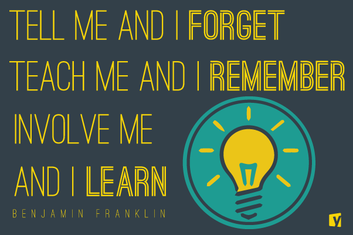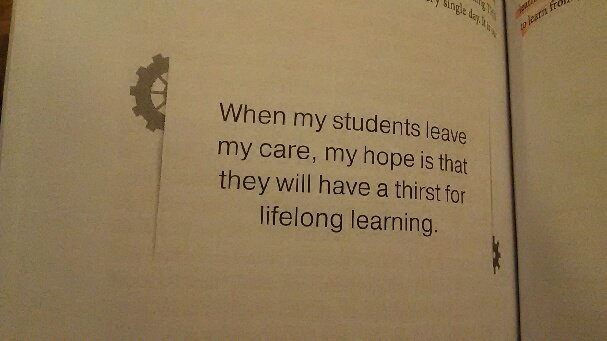
FINALLY! All classes taught (the Summer Reading Program for Freshman Struggling Readers for the high school and Intro to Speech for the community college) and taken this summer (Online Learning training courses) are completed. I can rest my mind for three whole days before Speech Camp begins; this summer is flying too fast. This summer has been one of reflection and growth as I approach the start of my 10th year of teaching while challenging me to seek balance as a mom and educator. Since online learning has been such a focus this summer, I sincerely approached this relatively uncharted territory with some reservations, seeking to find the differences between traditional and online learning. My reservation lay mostly in the subjects I teach, communication and humanities, which rely on face-to-face interaction and nonverbal communication. As the summer continued and I engaged with more instructors at various levels of teaching/experience with online learning also in these fields, I was encouraged, surprised, and eager to overcome the minor barriers to some day provide positive and growing experiences for students in this academic area.
The two topics I previously addressed include: Read "Online vs. Face-to-Face Instruction (Part One) HERE
- Start with organization. Always have a Plan A, Plan B, and maybe even a Plan C.
- Prioritize relationships and tone setting.

3. Student Engagement is #1 - Regardless of Format
Students who participate in online learning expect to be more independent with their work, the pacing of the course, and the activities in which they are required to engage. Because of the asynchronous nature of e-learning, students are expected to be more independent to comprehend content, participate, and complete tasks assigned. That being said, students still need additional support and want to feel connected to their peers, the content, and their instructors on some level. As instructors in any format, it is so important to allow our personalities, interests, and passions to shine through our instruction and content delivery. When we engage in self-disclosure ourselves, students feel a natural connection to the course, are far more likely to log in and participate and will share personal connections and insights. The act of self-disclosure can enliven discussion (forums or face-to-face conversations), lead to higher quality work, and start a dialogue of questions and resource sharing that can lead to further understanding of curriculum by all.
Engagement is pivotal to students' overall experience with the course, attitude toward the content/instructor/peers, and ability to retain information. In an online format (or again, any format), students should share resources, complete outside research (with credible sources), and forge deep connections between the information being learned and class and their lives. An onslaught of recent research studies and articles have addressed the changing needs and expectations of students, which is often attributed to the shift in technology and the frequency of connectivity thanks to mobile device, are centered around the idea that students seek information that is relevant to their lives, useful to their careers or present goals, and involves student-centered work. As such, we ought to work to ensure that curriculum design provides opportunities for students to engage in learning in ways that allow them to take control and feel ownership of their learning. When they are connected to what they are reading, producing, and creating, the learning becomes more meaningful.
Today's students need to apply critical thinking skills and move beyond recalling (or Googling facts). Written communication becomes a necessary skill as students are assessed by their peers and professors based on their grammar, ability to articulate ideas and the tone that is infused with their writing style. Through online interactions and engagement, students develop far more skills than just the those related to the course content. As instructors, we must guide, support, and encourage them to be engaged by being present, active ourselves, and modeling strong communication skills that will enhance their experience and motivate them to continue to log back onto the course's learning management system or in the case of a traditional high school classroom - keep them from scrolling on their phones and tuned into class each day.

4. Online learning challenges us as educators to incorporate the most up-to-date research and resources.
When students are accessing a majority of course material, and in turn producing work online, a vast sea of information is available with a few simple clicks and key word searches. We are all exposed to a slew of information with every hyperlink we select. As such, we are now challenged with revamping and revising resources to keep pace with the ever-changing landscape of the Internet. Through the experiences I have had this summer, I realize that while this may seem like a daunting task for instructors at any level to keep up with the current research, articles, news, and trends - instructors are not the ones that need to be doing all of the curating. In fact, when students are taught to effectively research and seek out credible resources, they become the fact-finders and presenters of new information. Through discussion forums, students can locate information that pertains to their interests and learning goals, share and discuss the information they find, and synthesize the knowledge they gathered with course content. Providing citations and links to both students and the instructor alike, students lead the charge of maintaining relevance all while engaging in meaningful critical thinking and researching activities.
All of this being said, reinforcing research skills becomes crucial. While it seems as though instructors at every level K-12 incorporate research projects and activities, students often forget or simply block out key strategies and reminders about credibility, how to utilize online databases such as EBSCO and Google Scholar, and cannot for the life of them accurately cite a source using the correct version of APA or MLA even though quality, paid resources like Noodletools or the Purdue OWL provides all the information for them that they could need, students still need guidance in this area. Conducting a fast Google search is convenient and often seems to produce reliable results. As instructors, we need to take the time to explain why credibility matters, how going beyond a Google search can help them in their future careers, academic courses, and even daily lives, and how to evaluate and apply the information they find. These skills require continuous guidance, support, and reinforcement, which is perhaps an explanation as to why my high school students CLAIM they never had to create a works cited page. Students, I see through you and your youthful and often innocent attempts to prevaricate the truth.
My final thoughts:
Through these courses and experiences with online classes as a whole, I have come to realize that quality teaching is quality teaching no matter what platform is used to deliver the content. Students need passionate and personable instructors who teach them essential academic skills that will not only lead to immediate success in the classroom but also life success in any avenue students choose to pursue. While shifting one's methods of teaching to accommodate a different modality can be overwhelming or teaching a course for the first time can become a time-consuming and meticulous process, the same essential elements still must be implemented by instructors to ensure an engaging, rich classroom experience for students that involves relationships, relevancy, and dare I say it, even a little bit of fun!




